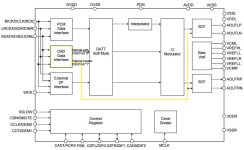There's actually 2 different paths for the DSD in the PD2. I can use the same block diagram as Srajan used in the review to explain. 1 path is through the AKM chip. If sent through this path it works much like the Merging NADAC as it goes through the SRC/SDM section of the DAC chips so DSP can be applied for things like volume control and additional filtering. The second way is the superior way. It bypasses the processing of the AKM chip, and uses high end discrete components on the output board to filter the DSD. This makes it very similar to the DSD section of the Lampi GG, although the DSD traffic is being directed through the chip. Since this is such a minimalist approach with the purest signal path, using external PCM to DSD upsampling like Hqplayer, and like I will have in my server, transforms the PD2 into super DAC territory. The combination of both makes it more like the Mola Mola, Emm labs, dCS etc DACs, only rather than using low powered FPGA's or DSP chips for the SRC/SDM, (sample rate conversion, and sigma delta modulation) a much more powerful quad core I7 Intel processor is used. This allows far more sophisticated algorithms to be used than are possible on FPGA's or DSP chips. For example the filter I will use in my server for upsampling has 4 million taps!
You can read a bit about taps here and why they matter:
"In order to do this the filters need to have infinite long tap lengths. Currently all reconstruction filters have relatively short tap lengths - the largest commercial device is only about 256 taps. It is due to this short tap length and the filter algorithm employed that generates the transient timing errors. These errors turned out to be very audible. Going from 256 taps to 2048 taps gave a massive improvement in sound quality - much smoother, more focused sound quality, with an incredibly deep and precise sound stage.
The initial experiments used variations on existing filter algorithms. Going from 1024 taps to 2048 taps gave a very big improvement in sound quality, and it was implying that almost infinite tap length filters were needed for the ultimate sound quality. At this stage, a new type of algorithm was developed - the WTA filter. This was designed to minimise transient timing errors from the outset, thereby reducing the need for extremely long tap lengths. The WTA algorithm was a success - a 256 tap WTA filter sounded better than all other conventional filters, even with 2048 taps. WTA filters still benefit from long tap lengths; there is a large difference going from 256 taps to 1024 taps.
The new Chord products using WTA filters all start with 1024 taps. The filters are implemented in FPGAs (Field Programmable Gate Arrays) using a specially designed 64-bit DSP (Digital Signal Processing) core".
http://www.chordelectronics.co.uk/chord-dac-technology.asp
The yellow path is the DSD direct mode. And the other path passes through the chips SRC/SDM section like all DAC's with the Sabre chip.
How MSB does it, they don't talk about much openly. But it goes through the Sharc DSP chips, and either uses discrete components for filtering, or low pass filters implemented in the DSP chip.

